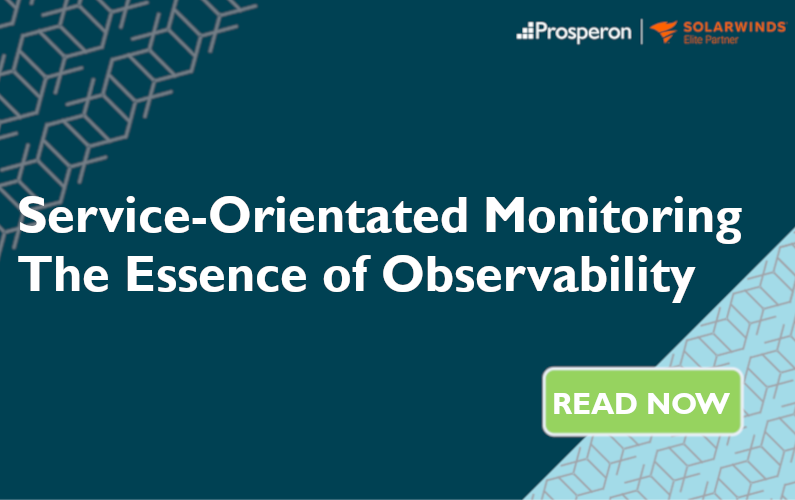Service-Orientated Monitoring – The Essence of Observability
Do I know Observability?
You all know what Observability stands for in the IT world; if you don’t already know it, check out this page. Basically, it’s the ability to understand the internal state of a system by monitoring its external outputs.
As part of my training, we had many internal sessions on these concepts and how it is being applied in customer environments. I could wrap my head around it, and then I couldn’t. Aaarghhh! It didn’t make sense! I was struggling to see what was new here. And then, one fateful day, I jokingly explained to Mark Roberts (our resident monitoring wizard) how I thought it was all a gimmick! I am glad I did that! What followed was a truly eye-opening discussion, and there are several key takeaways I wish to share in this post here!
While Monitoring is a reactive approach, Observability is proactive in nature. While Monitoring shows you what is happening, Observability explains why something is happening. While Monitoring checks if our system is working, Observability finds what our systems are doing. Monitoring collects data, whereas Observability is designed to collect and enrich the data. And finally, where Monitoring is focused on detecting known problems, Observability is focused on solving complex business problems.
But I was missing something here. At Prosperon, we believe that Observability isn’t just about technology and tools. Service-Orientated Monitoring (SOM) is an integral part of Observability. Service-Orientated Monitoring focuses on the end-user experience and business services rather than individual components, with the goal of aligning IT Monitoring with business objectives and improving overall service quality.
Consider this scenario: Your business is booming, serving more customers and building bigger teams. You need new applications, services and new integrated business processes to meet the growing needs of your business.
What does this mean for your IT teams? More applications, more cloud services, integration with existing services, and a lot more physical or virtual infrastructure to support your business’s outcomes. They need to monitor more and more elements as your business grows to ensure the impact to business from unplanned technology-related issues is minimal. They now have tens of thousands of metrics from individual elements, services, applications across the entire digital ecosystem of your business to monitor. What is the approach to tackle this? How do you put together the pieces of the puzzle?
Service-Oriented Monitoring (SOM)
SOM is a strategic approach to IT monitoring that focuses on the performance and availability of individual services within your organisation. By monitoring services independently, organisations can gain valuable insights into their interactions, dependencies, and overall health.
By adopting a holistic approach that combines SOM and Full Stack Observability, you can gain valuable insights into your IT infrastructure, optimize performance, and ensure the reliability of your applications. This approach is essential for managing complex modern IT environments and delivering exceptional user experiences.
This is the Essence of SOM and Full Stack Monitoring. SOM focuses on monitoring the performance and availability of services that are business critical. It provides visibility into how services interact and identify dependencies that could affect the delivery of your service. You only need to worry about what is critical to your service, ensuring you have the right insight to predict and react to any hurdle you encounter.
I trust that the first part of this Blog has been thought-provoking, and in the interest of not overwhelming you with everything that Observability can do – I will round up here.
Please stay tuned later this month for a Deep Dive into implementing SOM and Full Stack Monitoring.

Amal Jacob John
Presales Engineer
Amal is a Presales Engineer at Prosperon. As a Presales Engineer, Amal specialises in helping organisations adopt and leverage solutions to enhance their technology infrastructure. With a strong background in strategic technology consulting, Amal is committed to driving business transformation and building lasting customer relationships.
Demo: SolarWinds Hybrid Cloud Observability
Demo: SolarWinds Hybrid Cloud Observability
Exclusive Event: SolarWinds Discovery Forum
Exclusive Event: SolarWinds Discovery Forum SolarWinds Discovery ForumIn this SolarWinds Discovery Forum, on Tuesday 25th March, you will discover how AI-driven...
A Deep Dive into Service Orientated Monitoring
As promised, the Deep Dive is here! We kicked off in the previous Blog to this series on Exploring the Concept of Service Orientated Monitoring and now, as promised, it’s...
Hybrid Cloud Observability Enables Consolidated IT Service After Merger
CHALLENGE Prosperon Networks’ client, a global law firm providing insurance, transportation, energy, infrastructure, trade, and commodities services to clients, engaged with...

